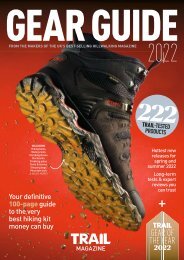308
You also want an ePaper? Increase the reach of your titles
YUMPU automatically turns print PDFs into web optimized ePapers that Google loves.
good to know<br />
As the seasons change and<br />
days become shorter,<br />
we’ll soon be driving<br />
in the dark more often.<br />
If driving in the dark<br />
worries you, follow our guide to<br />
staying safe when behind the wheel at<br />
night, with expert tips from the AA.<br />
Check your eyesight<br />
Naturally our eyesight begins to<br />
deteriorate as we get<br />
older. It’s important to<br />
regularly see an optician<br />
to ensure your sight is<br />
good enough for driving,<br />
especially if you’ve<br />
noticed you’re struggling<br />
to read road signs or get<br />
easily dazzled by bright<br />
headlights.<br />
A clear view<br />
It may sound obvious,<br />
but before setting off<br />
check your wipers. Are they working<br />
properly or are they making smearing<br />
Test yourself:<br />
You must be able to<br />
read (in daylight with<br />
glasses if necessary)<br />
a car number plate<br />
from 20 metres away. If<br />
you’re struggling to do<br />
this, visit your optician.<br />
worse? Be sure to clean the inside of<br />
your screen to make sure the dirt isn’t<br />
on your side of the glass.<br />
If you can, dim your dashboard<br />
lights, this will help reduce reflections<br />
onto the screen, giving you better<br />
night vision.<br />
Ditch the dazzle<br />
If you find yourself being dazzled by<br />
oncoming lights focus on the left-hand<br />
kerb and keep your speed<br />
steady. If that doesn’t work<br />
slow down or pull over<br />
and stop until your eyes<br />
have fully adjusted. As<br />
we age it takes longer for<br />
our eyes to recover from<br />
dazzling lights, it increases<br />
from one second as a<br />
teenager to nine seconds<br />
as we reach retirement.<br />
Let it shine<br />
As a simple rule of thumb,<br />
turn your car lights on an hour before<br />
sunset in the evening and an hour<br />
after sunrise in the morning. This<br />
should ensure you’re clearly visible in<br />
dimly lit conditions.<br />
Take it steady<br />
At 60mph your headlight’s reach is<br />
around 180ft on low beam. When<br />
travelling at 60mph it takes more than<br />
200ft to come to a complete stop so<br />
it’s advisable to drive slower at night<br />
then you would in the day.<br />
When driving on country roads<br />
avoid reducing your speed when<br />
there’s oncoming traffic and then<br />
speeding up again. This makes it very<br />
confusing for drivers travelling behind<br />
you. Drive at a speed you can maintain<br />
and stick to it, even if there are times<br />
you could go faster.<br />
Help others overtake you<br />
If someone is overtaking you keep<br />
your full-beam lights on until they’re<br />
alongside you. This will help them see<br />
the road better and avoid any accidents.<br />
n For more information about AA<br />
breakdown cover, call 0800 085 2721<br />
Night driving<br />
Be confident driving in the dark with these simple steps<br />
By Lorna White<br />
Don’t forget:<br />
The clocks go<br />
back at 2am<br />
on October 28<br />
50<br />
YOURS n EVERY FORTNIGHT<br />
pics: shutterstock

















